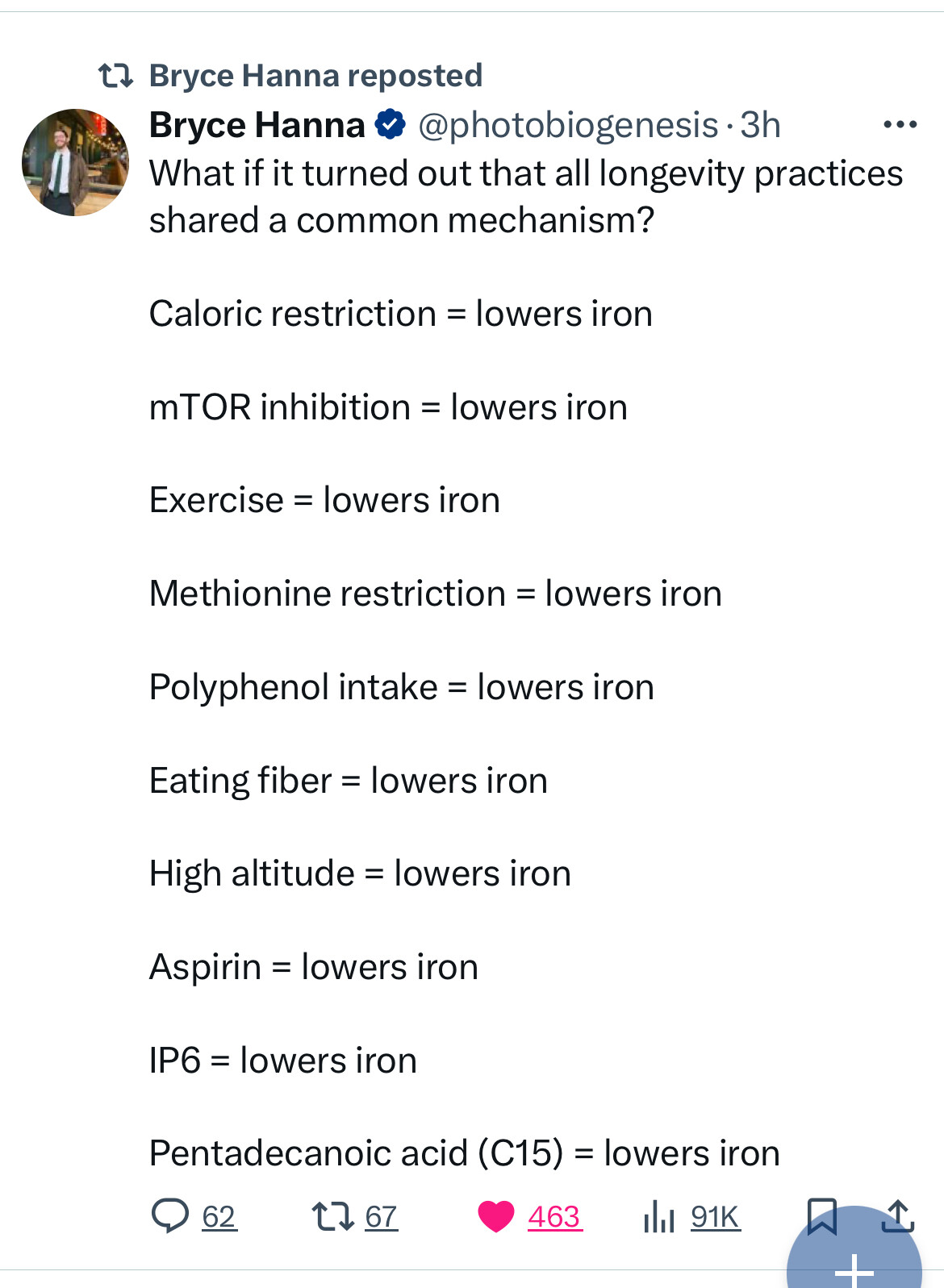I don’t know this guy but I thought he made an interesting point about iron
P D Mangan covered very similar ground in his 2016 book dumping iron. He also wrote an article on it noting how many longevity drugs/compounds being tested are iron chelators.
The interesting question is how high are the mouse iron levels in all these different labs compared to the ITP mice and is that difference driving the fact that so many compounds which show success in early testing fail the ITP?
Alfatradiol doesn’t lower iron.
Funny that study that showed the centenarians had high Iron. It is a puzzle.
Half jokingly - but maybe that’s why the centenarians don’t reach 120? ![]()
Iron accumulates with age do that’s not surprising. The question is why didn’t the high iron stop them…or maybe it did eventually.
My next blood donation is next weekend.
But why did those with low iron die earlier?
@adssx According to the paper: high iron in tissues vs low iron systemic availability…from inflamaging:
“ Factors responsible for age related systemic iron depletion, other than poor diet and use of certain medication, may include elevated levels of circulating hepcidin due to underlying chronic inflammation [15]. However, further evidences are required to explore the effects of aging, iron status, and inflammation on regulation of hepcidin [14]. Iron stores in tissues are found to be increased with aging. This increased intracellular iron induces deleterious effects on cellular functions due to redox imbalances leading to ferroptosis that contributes to aging and associated morbidity and increased mortality [16]. The low systemic iron availability and increased intracellular iron levels may be linked with increased production of hepcidin due to underlying chronic inflammation associated with aging”
Visceral adiposity is associated with iron deposition and myelin loss in the brains of aged mice
Connection between visceral fat and high iron (and disease) in the brain.
Visceral fat —> inflammation—>iron absorption
Open Access Paper:
Metabolic diseases may be prevented by reducing carbohydrate intake and replacing plant-based diets with animal-based ones low in carbohydrates but high in protein, fat, and iron. While the effects of sugars on metabolic diseases are well-known, the role of iron remains unclear. This study aimed to explore the effects of a high-fat high-iron animal diet on body metabolism in mice. Micro-PET imaging was used to assess 18-F-labelled glucose uptake in BAT, and the morphology, respiratory function, and oxidative stress of BAT mitochondria were examined. The underlying mechanisms were elucidated by analyzing the expression of UCP-1, PGC-1α and PPARα. The high-iron high-fat diet increased appetite, impaired glucose tolerance, and reduced insulin sensitivity. Additionally, the high-iron diet promoted gluconeogenesis only in the absence of high-fat levels. Both high-iron and high-fat diets suppressed BAT activity, increased mitochondrial oxidative stress, decreased mitochondrial respiratory function, and lowered thermogenic gene expression. Weight loss strategies focusing solely on reducing carbohydrates and increasing animal foods, like ketogenic diets, may have long-term detrimental effects on metabolic health. Prioritizing dietary diversity and monitoring overall caloric intake is advisable for optimal outcomes.
https://www.sciencedirect.com/science/article/abs/pii/S0006291X24015444?via%3Dihub
Wondering if I should stop cooking with a cast iron pan
Just my opinion, but the seasoning keeps it separate pretty well, Iron oxide isn’t that absorbable. I think the amount you get is trivial. I’m loaded with Iron,but expect it mostly comes from red meat. My daughters cook with cast Iron and they’re all short on Iron. Pretty sure this is not the problem.
I pay the extra money for a non stick stainless steel pan
Do you mean carbon steel or a coating?
I think it’s unwise to cook food on something that would be toxic to consume so am avoiding nonstick coatings
Original Research: Open access.
“Exploring the links among brain iron accumulation, cognitive performance, and dietary intake in older adults: A longitudinal MRI study” by Brian Gold et al. Neurobiology of Aging
Another whole blood donation for me this weekend. Dump that iron! And whatever old factors I can also dump.
Surprisingly people who give blood have a higher risk of Parkinson’s disease: Blood donations, iron stores, and risk of Parkinson's disease - PubMed
Just more proof that everything is associated with everything. The blood must go!
I don’t think so. They also tried an iron chelator in a recent RCT in PD and it made symptoms worse despite lowering iron levels.
I’m not arguing for or against blood donations. Just pointing that iron metabolism is probably very complex and we can’t conclude “Lower iron = good so blood donation = good”.
I agree Iron metabolism is complex. However, there is an association between lower ferritin and better health and iron overload is clearly an issue.
I give between 10 and 25ml blood a week for testing. Gradually ferritin has come down as well.

